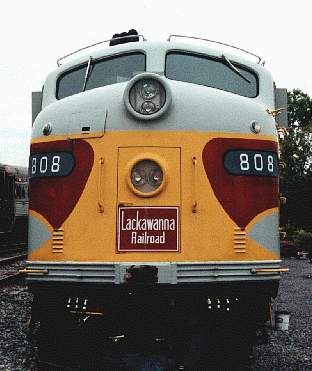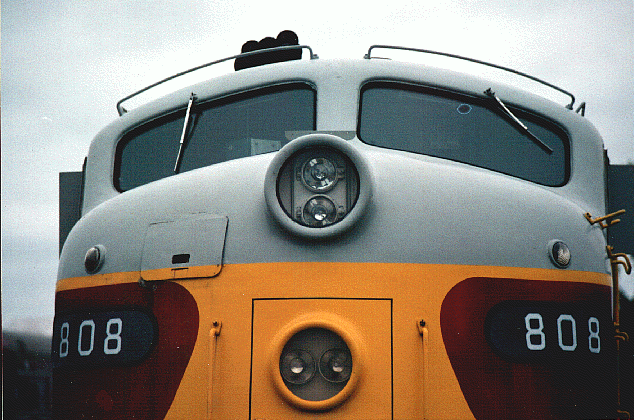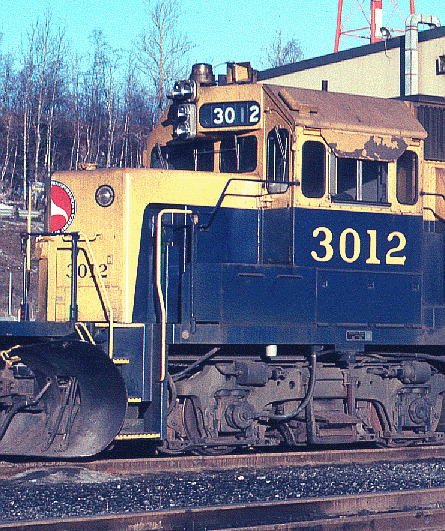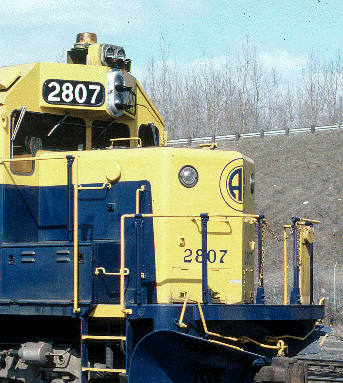This website has been archived from TrainWeb.org/gyra to TrainWeb.US/gyra.
This website has been archived from TrainWeb.org/gyra to TrainWeb.US/gyra.
The locomotive shown below (Lackawanna No. 808 E8) is unique in having the 2 headlight openings using fixed dual headlights in each. A locomotive with 2 headlight openings usually had an oscillating light in the upper opening.


The E-8 was originally built by EMD for the Pennsylvania Railroad on Order No. 2054 (b/n 16771), and delivered in Sept. 1952 as #5702A. At some point it was renumbered by PRR to #4272A. It kept this number into Penn Central, and subsequently into Conrail. When it was obtained by N.J. Transit, they changed it to #4305. Ultimately, NJT put their E units up for bid, and A/O Aug. 31, 1987, it belonged to the Central NY Chapter, NRHS. The unit arrived in Syracuse in early December, and over the next 4 years, it was fully restored and transformed into the Lackawanna #808. On Oct.14, 1991, it re-entered revenue service on the Lackawanna Limited excursion from Tully to Binghamton.
When we received the #4305 from NJT, the nose door had been welded shut, and there was ONLY one headlight (the upper one). We painted the nose door back on, and using a nose door we obtained, we fabricated that light. We did NOT replace the nose door on the #808. We mounted a door handle and PAINTED the outline of the door. The light was FABRICATED from another nose door, and the light was made operational.
The Lackawanna #807 E8 also has 2 headlight
openings:
The E-8 was originally built for the Pennsylvania Railroad in 1951? as their #5761A. At some point they renumbered it to #4261A. It kept this number into Penn Central, and subsequently into Conrail. In fact, the locomotive retained this number until it was transformed into the Lackawanna #807.
To continue the story, Conrail sold her to the MBTA for commuter service. When the 'T' divested their E-8's, she was bought by the Green Mountain Railway Corp. and moved to No. Walpole, MA/Bellows Falls, VT. As far as we know, they only used the steam generator, never using the locomotive in revenue service.
My son Todd had researched the extant E's in an effort to find a mate to our Lackawanna #808. We contacted the GMRC, and found they were interested in working out some kind of trade. Subsequently, it was decided that they would exchange the E for our ex-B&M F7A #4265A (which we acquired in 1981 and cosmetically restored for our Historic Train exhibit at the State Fairgrounds), and our RDC-1 #53 (originally New York Central #453-see RDC history reference sheet), plus various RDC parts from one that we had scrapped (originally NYC #461- ditto ref. sheet).We then prepared both pieces of equipment for interchange, and they were shipped to the GMRC in 1994, while we, in turn, received the E-8, which was to become the Lackawanna #807.
The nose door on the
#807 WAS replaced with one which had a headlight. [The #807 was received with
an operable nose door (w/o headlight]. We obtained another nose door (with
headlight) and replaced it.Unfortunately, at this time the light is NOT
operational due to lack of certain equipment.The
#807 and #808 DO look identical except for the fact that the nose door
headlight mounting on the #807 has a "drumhead" in it.
Both units were painted by chapter personnel using authentic Lackawanna paint diagrams, stencils, etc
__________________________________
The locomotive (3012) in the photo below shows 2 dual headlight units. It could be that the lower (vertical) dual headlight unit was installed to replace a 20585 Gyralite.

Alaska No. 3012 GP40-2
with 2 sets of dual headlights and a PM-8901 beacon
photo from: Bill Navari collection

Alaska
No. 2807 GP49 with dual horiz. headlight, Vert. 20585
Gyralite and PM-8911 beacon
photo from: Bill Navari collection
by Timothy Organ
Phase 1: Amtrak receives a fleet from other RR's when it was created, and the fleets units reflect the different light applications of the home road that ordered the power (ex BN power, ex SP power, ex UP) originally.
Phase 2: As the fleet is repainted and brought into a common pool, this new fleet has to be harmonized in terms of light packages. This light packet also has to meet the requirements of all RR's on the host roads where the power will run. Thus you can see in the photos how Amtrak appears to have decided on a light group as follows:
2 class light
2 regular headlights
1 white Mars/Gyralite type light ( sometimes 2 light unit)
1 red Mars/Gyralite type light
I suspect the most restricted host RR for lights would have been SP.
Phase 3: Amtrak places it first order for new power, the SDP40F's. The original like package for the units was: 2 class lights top headlight a white/red "Gyralite" type nose light regular 2 light headlight set up.
Phase 4: At some time, Amtrak is involved in the same "safety light program" that sees the application of white strobe lights. Other railroads that started applying these twin white strobe lights: Chessie System, Seaboard, B&M, CV. Thus the retrofit of the Amtrak units and turbos.
Phase 5: Amtrak places mass orders for the F40PH, with the now standard light package:
2 class lights
2 white strobe lights
1 red warning strobe
1 regular 2 light headlight.
Phase 5A: All orders received after the F40PH's receive these lights.
Phase 6: The FRA must have change the light requirements on locomotives, for all RR's start to remove class lights and "ditchlights" are now the standard extra lights. Thus all new Amtrak orders receive just the now standard 4 headlight package of 2 standard and 2 ditchlights. All older power in the fleet, upon major(?) servicing has any extra lights removed. ( The two web photos of Amtrak #503 I sent for example)
I wish I could confirm this via Amtrak, but based upon the examination of a number of photos, this appears to be the Amtrak light story.
I was going through a number of old Passenger Train Journal looking for a shot of Amtrak's EMD SDP40F's. I don't know how many of these units were equipped this way, but a number of them had their strobe lights mounted on the outside corners of the nose, just below the level of the bottom headlight. Thus the light set up was as follows:
Class light Gyralite Class Light
Strobe light Headlight Strobe Light
Safety Platform Light
(imagine looking at the face of the unit head on....) Unit shown is the following: SDP40F # 638, August 1980 on the Silver Meteor, page 22 of PTJ May 1986.
__________________________________
by Timothy Organ
1. October 1995 Mainline Modeler / page 77, contained in an article titled "CN's Rolling Stock Colors" by Stafford Swain. Pictured is a shot of CNR GP-9 4409, in the original CNR green/black/gold paint scheme. No date for the picture, but the unit is equipped with original ordered "barrel headlight" and has the portable mountain lights in use. It's a great shot, and a real early example of the use ditchlights. I will send you a photo copy via the snail main.
2. October 1987 Mainline Modeler, article on painting guide for Cotton Belt GP40's / GP40-2's. The pictures show Cotton Belt GP40-2 # 7249, 7240(SP) & 7950(SP). What makes these pictures usually is that in terms of timeline for new units: the units are still being equipped with the full SP light package, except that there are no class lights and the top mechanical SP moving gyrating light has been replaced with what appears to be a two lighted "oscitrol headlight". These pictures are as delivered from EMD.
3. Timeline pictures: Mainline Modeler, January 1986 in an article entitled "The EMD GP20", page 58, re CB&Q 900 - 935. One shot dated July 1962 shows CB&Q GP20 923 equipped with the as delivered white / red Gyralite (model ?) Next shot shows former CB&Q (still in Burlington paint) dated March 23, 1973 re numbered BN 2067. The unit has lost it's Gyralite, located plated over and has had the standard BN / Prime beacon applied.
___________________________________________________